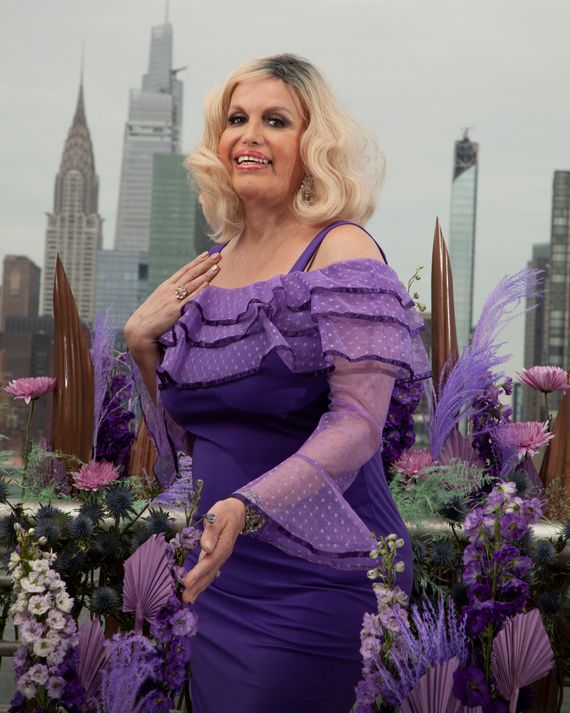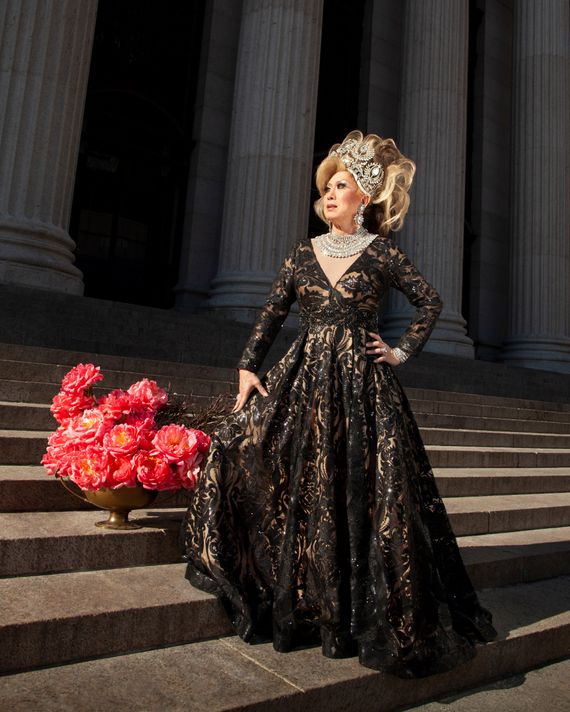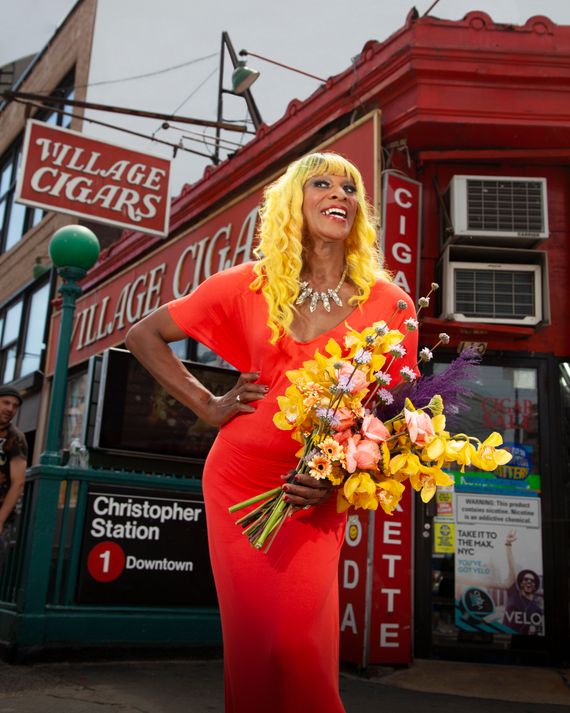
On the night of the winter solstice in 2017, Brooklyn-based artist Harry James Hanson and floral stylist Devin Antheus, both 32, paid a visit to Aunt Charlie’s Lounge, a queer bar in San Francisco’s Tenderloin neighborhood. They’d come for “church,” which is to say, a drag show. Antheus, who lives in San Francisco, was used to seeing older queens at the show, but Hanson, themselves a drag artist, mostly ran in circles of fellow millennial performers. They were awestruck to see so many queens of a certain age. “I was never part of any traditional drag house,” Hanson tells me. “I’ve had drag sisters, but never a mother. I do remember a time before Drag Race, but many kids today don’t. I’ve never heard stories of what things were like back in the day. I always had to seek them out.”
So Hanson and Antheus — friends since they were teenagers in Milwaukee, pregaming for Hanson’s Rocky Horror Show performances — decided to do just that: seek out stories of drag “back when.” The duo traveled to 16 cities across the country, taking portraits of 81 legendary queens. Hanson took the photographs, while Antheus paired each queen with a signature floral arrangement. “At the time there was this slogan that came out of the trans-liberation movement, where the girls are basically saying, Give us our flowers while we’re still here, and that struck home for me,” says Antheus. With the help of a “subterranean network” of queens across the country, they tracked down their subjects through word of mouth and on Facebook, where, Antheus says, “generationally speaking, the queens of a certain age tend to be,” as opposed to other social-media platforms. The images, and interviews with each queen, are published in Legends of Drag (June 21), a tome of living history that pays homage to queer icons who shaped what drag is today — and to the ancestors who shaped them.
Legends of Drag addresses the lack of intergenerational connection within the community: a broken lineage that’s often rooted in loss. “As queer people, we inherit a lot of generational trauma from various sources, but of course the AIDS epidemic is a big one,” says Hanson. “I not only think of how many entertainers we’ve lost, but also just the communities that were decimated, the mentors and mothers and collaborators and relationships that don’t exist because they were just wiped off the map.” But Hanson and Antheus don’t want to linger on darkness; queer history is too often framed by “tragic events,” Hanson says, and drag is about resistance and celebration. “Even during the AIDS crisis, people were still loving and celebrating.” It’s that capacity for joy that they want to capture: “This book underscores the power that queer people hold, not only individually but collectively, throughout time, forever.”
So what’s it like shooting legends? “A love fest,” says Hanson, who got so close with the Goddess Bunny (“a very picky bitch,” per Hanson) that she “informally adopted” Hanson and Antheus as her children. “She told us she was going to officiate our wedding, and we were like, ‘Actually, we’re not a couple,’” Hanson says. “And she was like, ‘I can tell! I can tell you have a love unlike any other that no one can break.’”
That sense of knowing, of motherly love, features prominently in the portraits of the five New York queens excerpted below — Barbra Herr, Coco LaChine, Harmonica Sunbeam, Simone, and Witti Repartee. They are saturated in color and brimming with jubilation, in rich regional flavor: In Herr’s portrait, the Chrysler Building is foreground by sprays of purple and lavender florals; in a bright-red dress, Simone beams in front of Village Cigars, across the street from the landmark Stonewall Inn. Witti Repartee holds a bouquet of lollipops (“Whores don’t like cut flowers!”) at the entrance to Luna Park in Coney Island. They each transform even the most mundane spaces. “Coco looks like she’s at the Met, but it’s actually the post office,” Hanson says. “Harmonica is literally sitting on a dumpster.”
Not all of the queens in Legends of Drag will see the photo book’s publication. Four — Phatima Rude, who used to be roommates with Antheus, Lady Red Couture, the Goddess Bunny, and Tina Devore — are with the ancestors now. “I have a deep love for each of my models. I don’t think of them as fragile, or that the fact that they are elders means that our time with them is more finite,” says Hanson. “That’s not at the front of my brain when I’m working with them. I think of them as these strong invincible warrior goddesses.” Still, when they lost their goddesses, Hanson and Antheus were struck by the importance of their project. They knew they had to hustle, they tell me, to give their girls their flowers while they’re still here.
Below, an exclusive look at a selection of New York City queens.
NYC | Virgo
Herr
"Drag is fun, but I don’t take it seriously like I used to, because I know I can do other things."
From: The Bronx, by way of Puerto Rico.
Original act: Bilingual lip syncing.
Bragging right: In 2014, wrote and starred in a one-woman cabaret show at the Duplex titled I’m Still Herr. In 2016, wrote the play Trans-Mission, winning a Latin Theater Award.
Drag origin story: Barbra’s mother, Mona, owned a social club in the Bronx. Mona recognized Barbra’s predilection for entertainment early on, and often dragged her child out in front of the crowd to sing Spanish boleros. Later, in 1973, while studying cosmetology, Barbra discovered the underground world of drag and immediately put her hair and makeup skills to use. She landed a gig in Old San Juan, at a straight venue called Cabaret, and through that scene she met Antonio Pantojas, one of the earliest pioneers of drag in Puerto Rico.
On performing, early on: “I was very old-school, but I never did impersonations. I used voices. My big go-to voices were Streisand, of course, and Shirley Bassey. I did a lot of disco divas and latin music, too. Most other queens [in Puerto Rico] didn’t know English, so being able to perform both brought me up quicker. Ironically, now living in New York and working in the Latin bars here, I started doing more Spanish songs. It kind of flipped.”
On performing, later on: “I stopped doing drag shows because they don’t fill me up anymore. Drag is fun, but I don’t take it seriously like I used to, because I know I can do other things. That changes the vibe.”
On identity labels: “I don’t even like the term transgender or transsexual, I don’t like any of that. In my opinion, we are all under the same LGBTQ+ umbrella, why can’t we all just be queer and call it a day?”
NYC | Virgo
Coco LaChine
“When I put on the makeup and wig and dress, I’m a completely different person."
Affiliations: The Imperial Court of New York. The LGBT Community Center.
Age: “Never ask an Asian drag queen how old we are; we always lie about our age.”
Signature flower: Peony, the queen of flowers in Chinese lore.
Drag origin story: “It began on Halloween. Then it became Valentine’s, then Pride. Before you know it, I was beginning to do it on a more regular basis.”
Bragging right: In 1994, included in Out Magazine’s inaugural “Top 100.”
On performing: “When I put on the makeup and wig and dress, I’m a completely different person. I’m not Charles anymore. I’m Coco. It’s a switch in my personality. My whole being changes when I dress up … It’s not just a façade for me. I transform into a different entity; not just a character, but a complete being. I’m not trying to act like someone else. I’m just me.”
On the New York scene: “In the old days, we’d impersonate personalities or entertainers: Judy Garland, Cher, Bette Davis. There are not many Asian celebrities I could impersonate. The most I could do was Connie Chung and read the news. It was one of my dilemmas in my early days. I used to perform every week at a club on 58th. It was a basement space, and one of the few Asian bars. There used to be two others, but none remain now.”
On consulting on the 1995 film To Wong Foo, Thanks for Everything!: “I gave lots of script comments. They took some and left others. They also asked me what to do in certain situations. I solved the problem of two winners — no pageant ever has a tie, so no pageant comes with two crowns ready to go. I told them to give one the crown, and have a scepter for the other. Patrick Swayze got the crown, and Wesley Snipes gets the scepter …The film shows a lot of things I told them to do: Patrick pops his finger on his lips, because he saw me doing it. And Wesley learned to put on his bustier from me: he puts the hook in backward and turns it around. The three main characters were all assigned a queen to work with. I was assigned to Patrick because I’m regal and classy and that was his role.”
NYC | Capricorn
Harmonica Sunbeam
"I just had to go out there and sell it. I did, and to this day there are still bitches who are jealous."
Hallmarks: Neon colors, rainbows, and textures matched only in vibrancy by her radiant personality.
Affiliations: House of Adonis. Drag Queen Story Hour. Gay Men’s Health Crisis. Hyacinth AIDS Foundation. African American Office of Gay Concerns.
Bragging right: Opened for Beyoncé at the Roxy in 2004.
Drag origin story: “Paris Dupree threw the Paris Is Burning balls. She was known for giving out the biggest trophies. She had a category called ‘Butch Queen First Time in Drags at a Ball,’ which is a gay guy getting in drag for the first time at a ball. I said I’d give it a try, and the house members totally put me together, I just had to go out there and sell it. I did, and to this day there are still bitches who are jealous. That means I won!” She started performing in shows at First Choice in Newark, N.J., and picked up the mic after the hostess didn’t show one night.
On performing, early on: “When I started doing drag, it was always the question of ‘Who do you do?’ Because we were ‘female impersonators.’ Everyone was fascinated with characters.”
On Paris Is Burning: “I was there, hiding from the cameras. Jennie [Livingston, the film’s director] would come to the balls. Sometimes they’d let her in, and sometimes they wouldn’t. Sometimes they’d throw her out in the middle of the function, like, ‘Okay, enough is enough.’ When people say the girls in it were exploited … well, it was a small project that became a big thing. When it came out there was this mixed reaction. It was great to have this moment, but also — oooh, girl — people who were in the closet were now outed. The Madonna situation garnered a lot of side-eye, because the general public was under the impression that Madonna started [ball culture]. I don’t think she did enough to tell the truth of, ‘Oh, I stole this.’”
On ambition: “I’ve always been one to create work for myself. A lot of people sit and complain that the phone is not ringing, but what are you doing to help the phone ring?”
NYC | Leo
Simone
"I have to be an example to these young girls. I was the only role model that I had. I didn’t look to anyone else.”
Stomping ground: Christopher Park, in Greenwich Village — the site of the Stonewall Monument. “When I’m here, I’m safe.”
Her act: Opens with “Last Dance.”
Drag origin story: “[In the ’90s,] I performed at lots of bars, lots of clubs. I was the first queen to perform at Lips restaurant and anyone who says differently is a fucking liar! Every night was wild. A lot of people were trying to make a name for themselves, trying to put an image out. Everyone was trying to come through and excite the people, give them something they can’t forget. Everything was glitter and spacey.”
On dropping the “drag” label: “I’m a performer. I don’t look at being beautiful as a drag queen. I fix myself up like any chick who wants to look nice. Performance is just a natural thing that comes out of me. I’m transgender. I’m a woman. I have to be an example to these young girls to show them the correct way to do something. I was the only role model that I had. I didn’t look to anyone else.”
On spirituality: “I can read people’s energy just like that. Astrology is in my family — my mother, my grandmother. We live our lives by it. We believe in god. I was born into an astrology world, to read people. I’ve had a gift since I was a kid. At first I didn’t know what it was, it scared the hell out of me. I thought I was crazy but my mother explained to me that it came from within the family and it was a gift from God. I’ve held onto it.”
On her motivations: “There are spirits everywhere [at Stonewall]. I feel these girls, Marsha and Sylvia. They want us to keep it alive, to keep it going on, for future generations. We need icons for young girls who are coming out to follow behind. We have to be examples for them.”
On performing during the pandemic: “I do the shows in the park to keep some life in the area. We’ve lost so much. We’re trying to stop New York from going out or dying away. People are leaving in droves. We’re trying to save this city. This is to give people something to do when they’re depressed.”
NYC | Leo
Witti Repartee
"As an eldest child, red-headed, Leo drag queen, did I need more confidence? Yes! All of that is smoke and mirrors to protect the fifth-grade fag.”
Affiliations: The Imperial Court of New York. Gay Male S&M Activists. NYC Gay Men’s Chorus.
Age: Celebrates the anniversary of her birth by turning 39 every year.
Signature flower: “Whores don’t like cut flowers — beauty cut down in its prime!”
How she got her name: “I appeared three times under the name Octavia Thunderpussy, until an ancient queen — younger then than I am now, mind you — said, ‘My darling, no! Octavia Thunderpussy is not the energy you’re presenting!’ She bestowed the name Witti Repartee.”
Drag origin story: “I was born into the theater.” Her parents met onstage, and she joined them for her first appearance by the age of three. Her mother once asked, “Who do you think put the first wig on your head?” It all grew organically out of dress-up time. At age 13, the summer after the Church Lady debuted on Saturday Night Live, Witti attended a theater camp. She discovered a purple polyester suit in the costume shop and thought, “Well, isn’t that special!” Witti continued in the theater department in college. In spring 1995, she made an appearance at a party in full Norma Desmond drag. “I was very clear that it was Patti LuPone as Norma, not Glenn Close!”
On her first gig: “My first professional paid experience in front of an audience of drag aficionados [singing at the Ice Palace on Fire Island], and I completely bombed! I hadn’t yet figured out who I was and who the character was. Riding the ferry back the next morning, I thought a lot about character development. I’m an actor who plays a character, and you need a backstory.”
On confidence: “As an eldest child, red-headed, Leo drag queen, did I need more confidence? Yes! All of that is smoke and mirrors to protect the fifth-grade fag.”
Legends of Drag: Queens of a Certain Age (6/21) is available for preorder here.










